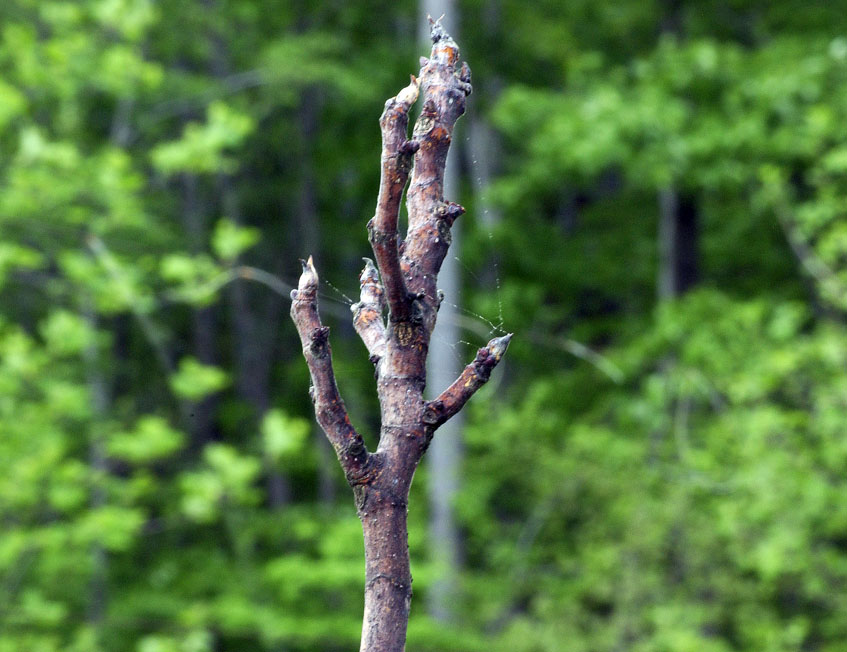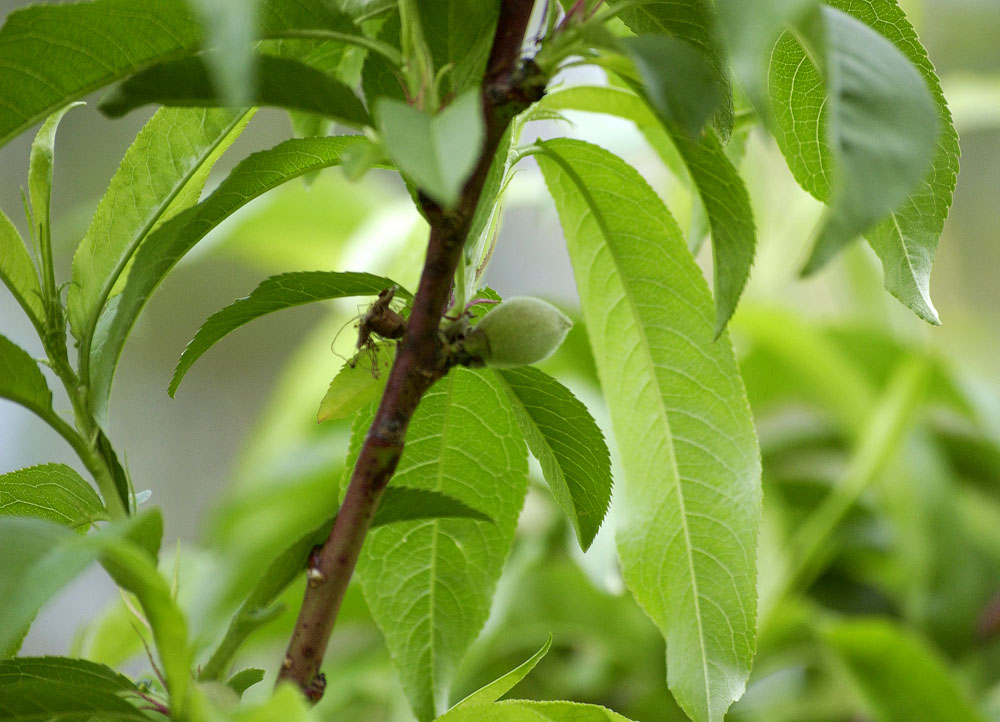
This apple tree looks spare and lanky because it was pruned heavily last winter. It won’t produce much fruit this year and instead will put all its 2014 effort into the growth of the tree. But, next year and in future years, the pruning will pay off.
Lucky is the man who has a mature, productive orchard. Starting an orchard is like trying to raise children in the Dark Ages — the investment is enormous, and the mortality and accompanying heartbreak run high. The oldest trees in the abbey’s orchard will be six years old this fall. The other trees vary in age, as trees that have been lost have been replaced. This process of death and replacement continues.
Among the lessons learned, a couple of things stand out. For one (as with dogs), know your breeder. Fruit trees that come from fruit-tree puppy mills may look nice when you see them at the big-box hardware store. But they may have come from nurseries far away, and they may be of stock and varieties that are not hardy and not suitable for your area.
The abbey’s strongest trees are all old Southern varieties of antique or heirloom apple trees from a nursery two counties to the east that specializes in such trees — Century Farm Orchards. Though I lost (and replaced) two of those twelve six-year-old trees, that mortality rate is good compared with the mortality rate of other fruit trees. We’ve almost given up on cherry trees. Insects defoliate them. We were on our second or third attempt at growing fig trees, and things were looking good, until the near-zero temperatures last winter killed the figs. So while the cherry trees, figs, and even the pears die of the whooping coughs, smallpoxes and scarlet fevers that afflict young fruit trees, the hardy old apple trees and peach trees carry on. Getting fruit trees to maturity is not a small challenge.
We were tempted to attempt olives. But we pretty quickly decided against it, because olives are not truly suited to this area, and the risk of mortality in any given year would be high. Even figs are a big risk. But we love figs so much that we soldier on.
If (at least in this area) you want maximum fruit and minimum grief in your young orchard, stick with apples and peaches, of old and proven varieties, from known nurseries with a track record and a nurseryman who will answer your emails (as David Vernon from Century Farm Orchards always does).

A fig stalk, killed by the cold winter, though its roots may still be alive



One of my fig trees was killed by the extremely cold winter. The other one looks great. My daughter & son-in-law are having success with their peach & apple trees too. Press on!
I’m surprised that the fig trees have been such a disappointment. Just a bit south, in Winston-Salem, our fig tree is prolific and trouble-free. We have two batches, early and late, every year without doing much to the tree but keep a pesky weed vine pulled off of it. The only problem is that the birds and ‘coons raid the tree before we can harvest the best fruit. The solution is netting, but waking to find dead birds hanged in the netting is a source of upset I don’t need right now.
We have an apple tree that produces a ton of apples and a pear tree that looks pretty in the spring but doesn’t produce much in the way of edible fruit. The apples that our tree produces are good for only two things: apple sauce and apple butter. They aren’t really edible raw, and they fall apart when peeled and cooked. Hence the apple sauce. I skipped the (very) labor-intensive process last year, but I’m going to do it again this summer.
You said the oldest trees are six years old. That can’t be. Has it really been SIX YEARS in Stokes? I’m amazed.
DCS
This problem with figs is a mystery. I know of fig trees in Asheville (much colder there) that are as big as a house. I think we will try to get some new fig trees this fall from our favorite orchardman.
By the way, we’ve had an indigo bunting hanging out at the feeders the last two days. Keep an eye out. They are incredible to behold and will stay only a day or two. No goldfinches at all this year.
DCS
Fig trees grow like weeds down here in GA. One of the nice things about GA, I guess. Our fig tree produces purple figs, and of course they are an amazing treat if you can keep the birds away. Cats are good friends of orchards.
We also have a nice apple tree that produces something resembling small, ugly golden delicious apples. They’re tasty if you can get them before the deer do.
Our little pear tree ain’t much to look at or to taste, yet, but she’s tiny. Give her time.
Honestly, if you like fruit (yes, that includes tomatoes), you could do worse than to live in the subtropical band. It does get mighty hot in July, but the fruit tastes sweet that time of year…